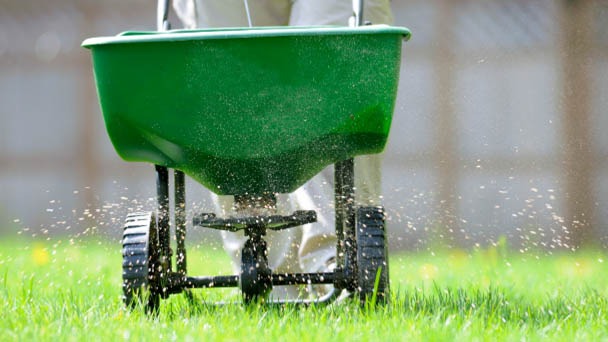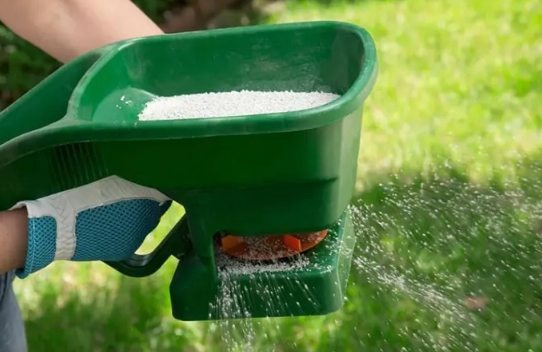When to Fertilize New Sod - New Sod Care Guide
Written by Ivy
Jan 03 2023

Congratulations on your brand-new lawn! You may be wondering when to fertilize new sod and what the best fertilizer is for new sod now that the sod installation is complete.
Generally speaking, taking care of new sod also typically entails knowing when and how much to water it, when to start mowing it, and when to fertilize it to promote growth. To give your new sod time to establish itself and get used to your yard, you should wait 30 days before fertilizing it. How to Care for New Sod contains more information on general after-installation maintenance.
When to Fertilize New Sod
Many lawn care professionals contend that it is best to postpone fertilizer application to new sod for around 30 days after installation. We disagree.
After being harvested, transported, and installed in its new setting, newly laid sod is under stress. Why not provide it with vitamins and minerals that will aid in its establishment?
What are the ideal nutrients for new sod, and where can you find them?
What's the Best Time of Year to Fertilize New Sod
It's best to do that at specific times of the year. When it comes to when I like to fertilize my own yard, I would say early Spring, late Spring, and possibly after early Fall, say September. Here, fertilization takes place at that time.
Regarding the new grass, I would recommend applying a half rate and carefully following the instructions on the bag four to six weeks after installation. Use a spreader. Never, ever just reach inside the bag and throw it out with your hand, which is what they call "chicken feeding the fertilizer." That is, as you can see, the absolute worst thing you can do for anything. In some cases, it might be acceptable for flower beds, but never ever do that to grass. For the first fertilization, you should only apply a small amount of fertilizer evenly distributed.
The Best Fertilizer for New Sod
The important thing here is that you DON'T want to use a fertilizer that's heavy with nitrogen. To the greatest extent possible, the new sod roots should be encouraged to ensnare the new soil.
Roots don't have to work as hard to cling to the new soil and successfully establish themselves when new sod is given nutrients like phosphorus and potassium.
It's not a bad time to apply nitrogen, but it's best if the ratio of nitrogen, potassium, and phosphorus—the three numbers on the fertilizer package—is as even as possible. A 15-15-15 or an 8-8-8 N-P-K ratio is therefore what you should be looking for.
What is the Best Time of Day to Water New Sod?
It's best to water your lawn in the morning or late at night, if your schedule permits. Watering your lawn in the afternoon during the warmest part of the day can cause the water to evaporate rather than being absorbed. Moisture deficiency can make it difficult for soil to retain vital nutrients that your lawn needs. If funds are available, think about purchasing a timed sprinkler that can be programmed to apply the ideal quantity of water at the ideal time of day.

How Much Should I Water New Sod?
To ensure that new sod is able to develop sturdy roots, regular watering is essential. If sod is applied during the summer, it should be watered throughout the day in order to prevent shrinking and drying. For at least two weeks after installation, you should water your lawn enough to ensure moisture is always present. You should then water your lawn for an additional two weeks to keep it from drying out.
Is It Possible to Overwater Sod?
Water loves grass, but new sod is a different story. Overwatering fresh sod is a possibility, and it can even happen more easily than you might think. New sod has very short roots which makes it harder for it to retain a lot of moisture. It is preferable to water new sod in brief bursts throughout the day rather than all at once with a lot of water. The roots of newly laid sod won't get the oxygen they require to thrive if the soil is overwatered. Overwatering can also cause disease when new sod is being planted in warm weather. Checking the soil's bottom a few minutes after watering can help you determine if your sod is being overwatered. You may be overwatering your new sod if, five minutes after your watering session ended, the soil beneath the sod is still wet.
How Long Should You Avoid Walking on New Sod?
Not walking on new sod too soon is the most crucial piece of advice we have for maintaining it. Pets, young children, and other people should stay off freshly planted sod at least until the first mow. Regularly watering the sod will help the roots take hold, and until they are well-established, your sod is vulnerable. Root failure or inadequate rooting can result from walking on the sod before the roots have had time to cool.
How Long Does It Take for Sod to Take Root?
Because the roots of new sod are so short, it's critical to treat them gently and avoid overwatering. Following installation, roots typically begin the process of establishing themselves after a week. The process may initially lag for up to two weeks in some circumstances. The amount of time it takes for the new sod roots to take root depends on the climate in your area, the season you plant your sod, and the quality of your soil. Take care never to overwater the sod while it is in the rooting stage. Root rot and eventual failure of new sod are both risks of soggy sod. Instead, water the sod more frequently, in smaller amounts, throughout the day.
The rooting phase is the most crucial in terms of sod maintenance. If you water your sod excessively, the roots won't be able to establish a solid connection with the soil. As you get closer to the first mowing period, you should reduce the amount of water you apply to the new sod. This will give the roots the necessary time to firmly anchor themselves in the soil as it dries out in preparation for the first mowing.
When you first mow the lawn, if the soil is too soft, you risk pulling the sod out by the roots and having to start over with new sod. Two to three weeks after the sod was put in, you should schedule your first mow. The roots of your sod need at least a month to establish before your first mowing if it was installed in the winter.
Should New Sod Turn Brown?
Before being sold for installation, new sod is meticulously grown. It can thrive because it is grown in a setting that provides the ideal ratio of nutrients, sunlight, and moisture. In general, new sod is extremely healthy and shouldn't turn brown. However, it is imperative to take good care of new sod. Sod needs to be installed as soon as possible because, like all living things, it is fragile. The sod may start to die and turn brown if the installers wait too long.
New sod will also turn brown due to drought or insufficient moisture. The roots enter a state of dormancy if they are not receiving enough moisture. New sod will turn brown during the dormant stage, but if it is not watered, it will die. If you see brown patches on new sod, there is a problem that is typically related to moisture or inadequate nutrients. Even if most of the new sod is yellow, it can still be saved. Brown new sod will be much more difficult to revive.
Latest Updated
- Benefits of Bugleweed - 7 Science-backed Health Benefits
- Bugleweed Dangers & Side Effects - Is It Poisonous?
- How to Plant Evergreen Trees - What You Should Know
- When to Plant Evergreens - Grow Guide for Evergreen Trees
- 12 Wonderful Evergreen Shrubs for Your Garden
- 12 Popular Evergreen Plants with Pictures for Beginners
- When And How To Prune A Lilac Bush Like a Pro
- How to Grow & Care for Lilac Vine (Hardenbergia Violacea)
- Japanese Lilac Tree (Syringa Reticulata) Care & Propagation Guide
- Shumard Oak Pros and Cons - What to Know
Popular Articles
- Winter maintenance of Antirrhinum Majus
- How to Grow Terminalia Mantaly Tree
- How to Grow and Care for Crossostephium Chinense
- How to grow Antirrhinum Majus in spring
- Peristeria Elata (Dove Orchid) Profile: Info & Care Guide
- Underwatered Snake Plant (Sansevieria Trifasciata) - Signs And How To Fix
- How to Care for Brazilian Jasmine Plant (Mandevilla Sanderi)
- How to Grow & Care for Graptopetalum Purple Delight in Summer
- Rosa Chinensis (China Rose): Plant Growing & Care Tips
- How to Care for Baby Sun Rose (Aptenia Cordifolia)